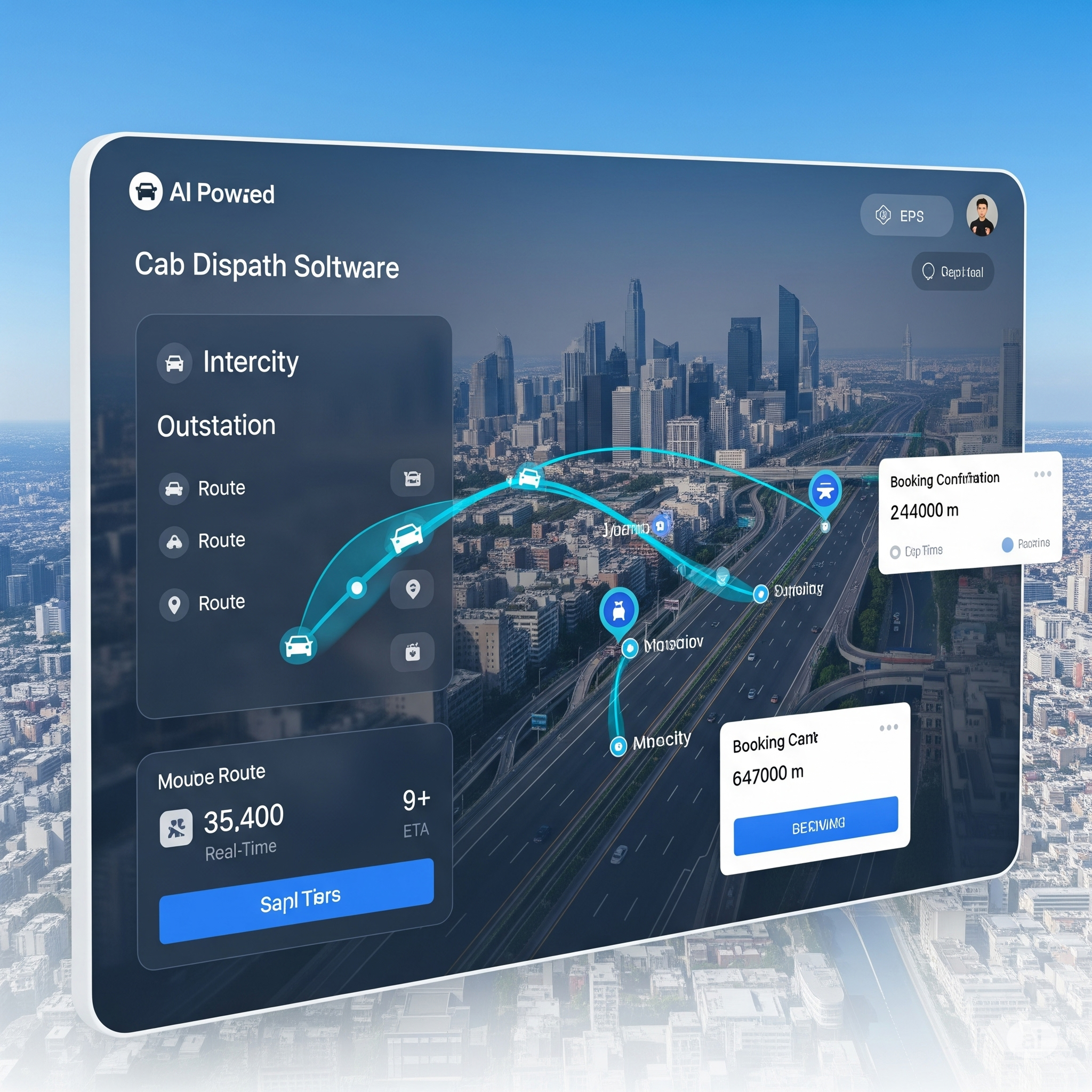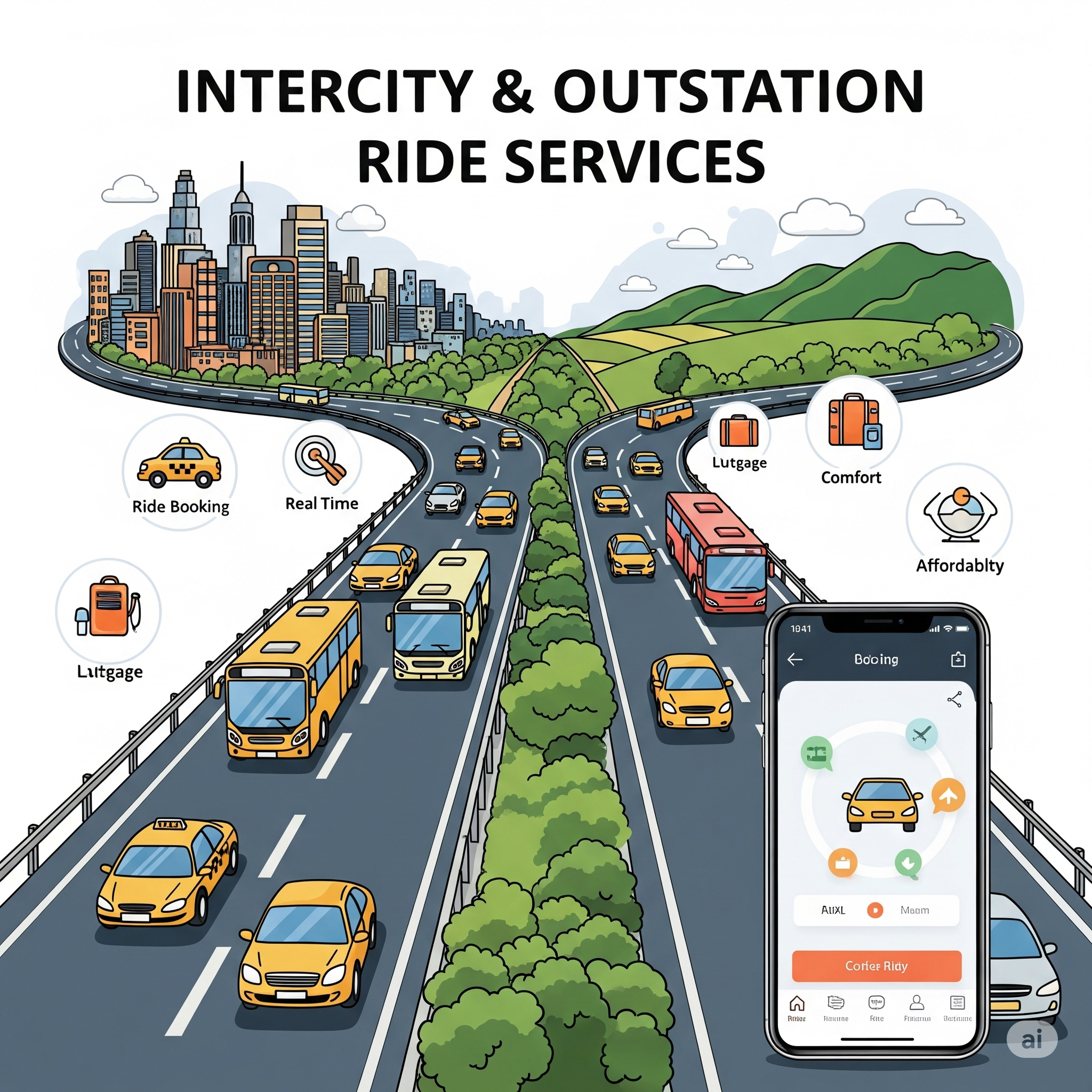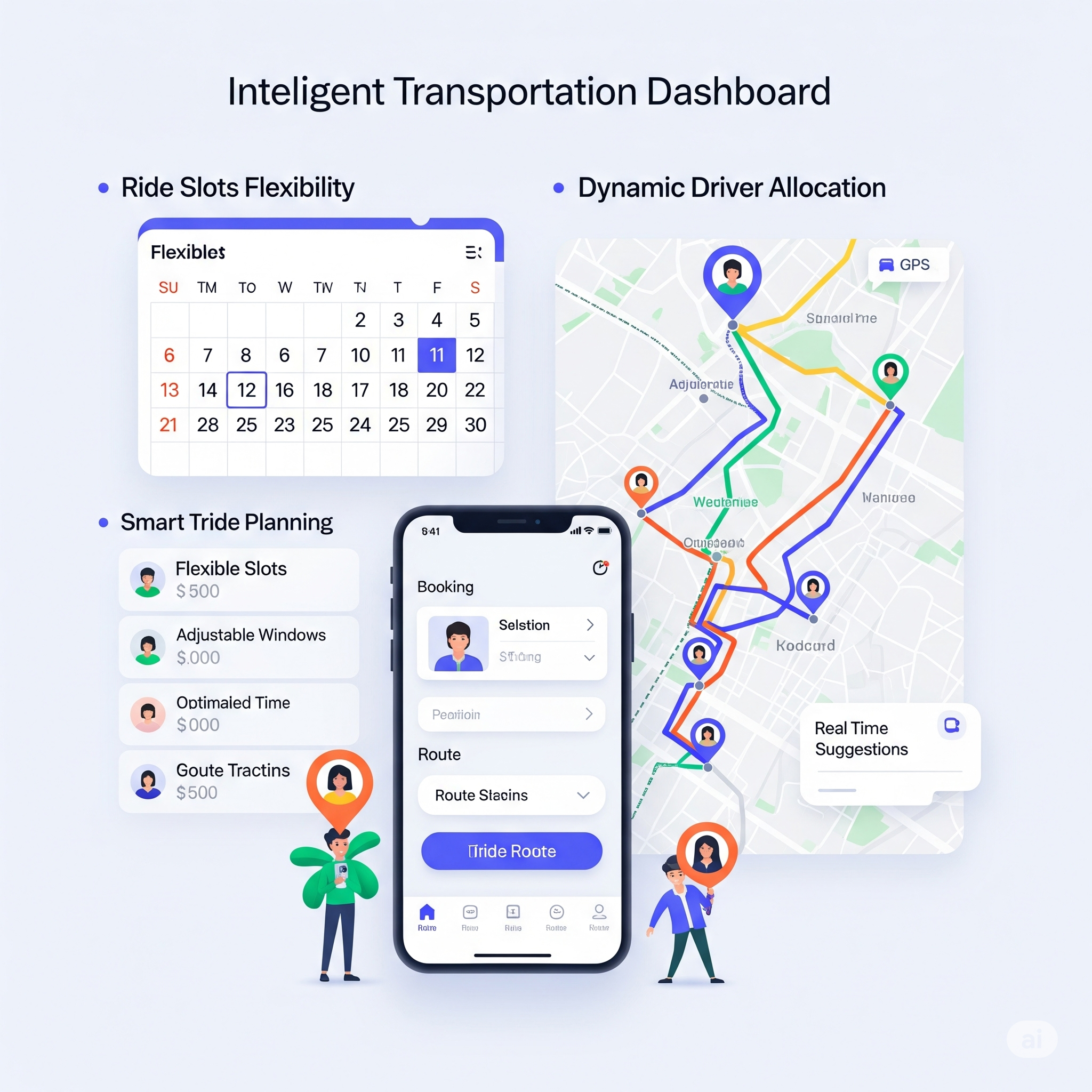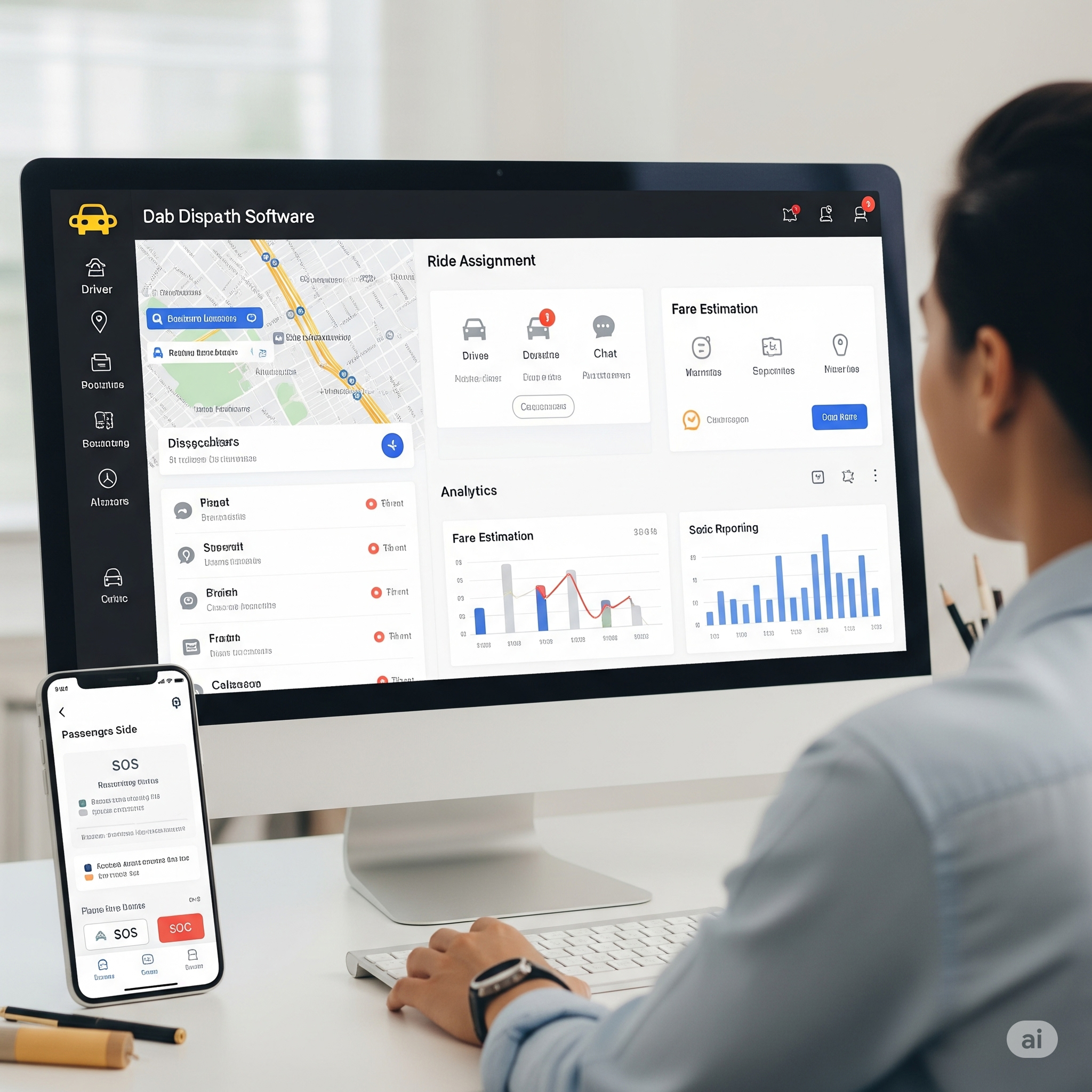Taxi Dispatch Software for Intercity and Outstation Rides: What to Look

In today's world of smart mobility, advanced taxi dispatch software plays a crucial role in reshaping travel. For intercity and outstation rides, having reliable and feature-rich taxi dispatch software is no longer a luxury—it’s a necessity. Whether you're a startup ride-hailing platform or an established fleet operator, deploying the right taxi dispatch system is essential for managing operations across regions and delivering a seamless customer experience. This comprehensive guide will explore the key aspects of choosing the ideal Taxi dispatch software for intercity and outstation rides, covering everything from core features and pricing models to scalability and future trends.
Importance of Taxi Dispatch Systems for Intercity and Outstation Travel
Unlike city rides, intercity and outstation trips involve longer travel durations, complex routes, driver shifts, fare variations, and intricate operational logistics. Generic taxi software often falls short in meeting these unique requirements. Dedicated taxi dispatch software addresses this critical gap by providing automated trip allocation, live tracking, pre-booking functionalities, and robust driver performance monitoring specifically tailored for long-haul journeys. This specialized approach ensures that the unique demands of extended travel are met with precision and efficiency.
Growing Demand for Regional and Long-Distance Ride Services by 2025
As of 2025, the demand for regional and intercity transport services has significantly increased. This surge is driven by several key factors: the widespread adoption of remote and hybrid work models has created a need for flexible travel options between cities. Weekend tourism, domestic travel, and improved connectivity with tier-2 and tier-3 cities have also led to a new wave of users seeking reliable long-distance ride-sharing and booking services. Companies that recognize this growing demand and invest in high-quality taxi dispatch software are gaining a competitive edge. By offering fast, transparent, and highly scalable mobility solutions, they position themselves as leaders in the evolving landscape of long-distance transportation.
Understanding Intercity & Outstation Ride Requirements

Long-distance travel introduces a distinct set of challenges and requirements that differ significantly from short urban commutes.
Unique Challenges of Long-Distance Ride Dispatching
Intercity travel diverges from intracity travel in several fundamental ways:
- Trip Duration: Longer travel hours require more sophisticated driver scheduling algorithms to ensure compliance with duty-hour regulations and to prevent driver fatigue. Additionally, rigorous vehicle condition checks are essential to guarantee safety and reliability over extended distances.
- Route Customization: Passengers undertaking intercity trips often have specific preferences regarding their routes. Drivers may need to take alternate highways to avoid congestion or make strategic stopovers for meals, restroom breaks, or scenic views based on passenger preferences or real-time traffic conditions. The software must be flexible enough to accommodate these dynamic route adjustments.
- Unforeseen Costs: Beyond the basic fare, intercity journeys can incur additional costs. Tolls, fluctuating fuel prices over long distances, and potential overnight stays for drivers (especially on multi-day trips) must be accurately factored into fare calculations, ensuring transparency for both passengers and fleet operators.
Booking Flexibility, Route Planning, and Driver Allocation Needs

Effective taxi dispatch systems for long-distance travel should provide both passengers and fleet owners with a high degree of flexibility:
- Passenger Flexibility: The software should allow passengers to pre-book rides well in advance, choose multi-city routes with designated stopovers, and even select specific rest stop preferences. This customization significantly enhances the customer experience.
- Fleet Owner Perspective: From a fleet owner's perspective, the software must facilitate smart trip allocation. This includes sophisticated algorithms that consider driver availability (taking into account upcoming shifts and rest requirements), real-time vehicle status (such as fuel levels and maintenance flags), and strict compliance with local and regional transportation regulations. This ensures optimal resource utilization and adherence to legal frameworks.
Core Features Every Taxi Dispatch Software Must Have

For intercity and outstation operations, certain features are essential for any robust taxi dispatch software.
- Real-Time GPS & Routing: Key for long trips, enabling smart navigation and precise ETAs.
- Accurate Navigation: Guides drivers with real-time, efficient routing.
- Live ETA Updates: Adjusts arrival times based on current traffic conditions.
- Multi-Stop Ride Support
- Scheduled Bookings and Pre-Booking Options
- Advanced Scheduling: Allowing bookings days or even weeks in advance.
- Reminders: Auto alerts for drivers and passengers.
- Transparent Pricing: Clear fare shown upfront.
- Smart Allocation: Assigns nearest available drivers.
Passengers on intercity trips often need to visit multiple destinations before reaching their final drop-off point. The best taxi dispatch software enables dynamic route planning with the capability to add multiple stopovers, automatically recalculating estimated times of arrival (ETAs) and fares for each leg of the journey.
Since intercity passengers typically plan their trips well in advance, a powerful taxi dispatch system must offer robust scheduling options, including
Dynamic Pricing and Fare Estimation
Unlike static fares for short city rides, intercity fares can vary significantly. A robust taxi dispatch software must support flexible pricing algorithms that can seamlessly handle multiple variables, such as
- Distance and Duration: The primary factors affecting the base fare.
- Tolls and Taxes: Automatic inclusion of all applicable tolls, road taxes, and government levies.
- Surge Periods: Dynamic pricing adjustments during peak demand or special events.
- Vehicle Type: Differentiated pricing for various vehicle categories (e.g., sedan, SUV, luxury).
- Outstation Charges: Special rates for intercity trips, often with return fare included.
Passenger-Centric Functionalities
A superior taxi dispatch system prioritizes the passenger experience, making the booking and travel process as smooth as possible.
- Easy Booking via Mobile and Web Apps: The taxi app should have an intuitive, user-friendly interface that enables passengers to:
- Select pick-up and drop-off locations: Easily set start and end points, including multiple stops.
- View vehicle categories and pricing: Clearly compare vehicle options and fare estimates before booking.
- Track booking history: View past rides, receipts, and frequent routes for convenience.
Live Driver ETA and Trip Tracking:
Customers expect complete visibility throughout their journey. Real-time updates on the driver’s precise location on a map, estimated arrival time at pick-up, and continuous trip status updates significantly enhance trust and satisfaction, especially during long-haul journeys.
In-App Support for Long-Distance Trips:
For lengthy journeys, passengers may require mid-trip assistance. Robust in-app customer support features, such as live chat, direct calls to support, and quick FAQs, ensure that help is just a click away, addressing any concerns or issues promptly.
Secure Payments and E-Invoices:
The taxi business software should support a wide variety of secure payment options to accommodate diverse customer preferences, including
- Digital Wallets: Integration with popular mobile payment platforms.
- UPI/QR Codes: Facilitating quick and easy payments.
- Credit/Debit Cards: Secure processing of card payments.
- Cash: For regions where cash payments are still prevalent.
Additionally, it must automatically generate detailed digital receipts (e-invoices) that clearly outline the route taken, fare breakdown (including tolls, taxes, and any surcharges), and payment method, ensuring transparency and ease of record-keeping.
Driver-Focused Tools & Automation
Efficient intercity operations rely heavily on empowering drivers with automated tools and intelligent systems.
Smart Trip Assignment for Intercity Routes:
The system should employ advanced algorithms to match drivers with intercity trips based on multiple criteria:
Experience: Assigning experienced drivers to complex or longer routes.
Location: Optimizing assignments based on driver proximity to the pick-up point.
Vehicle Readiness: Ensuring the assigned vehicle is suitable for long-distance travel and has undergone necessary checks.
Return Trip Optimization: Smartly assign return trips to reduce dead mileage, cut downtime, and boost efficiency.
Rest Stops and Shift Planning:
Long rides require mandatory rest planning for drivers to comply with safety regulations and prevent fatigue. The taxi taxi dispatch software should automate:
- Rest Break Alerts: Notifying drivers of required rest periods based on trip duration and regulations.
- Shift Timings: Managing driver shifts and ensuring compliance with working hour limits.
- Overnight Stay Management: For multi-day trips, facilitating the booking and management of driver accommodations.
Payout Calculation for Distance-Based Fares:
Automated earnings calculations are essential for driver satisfaction and operational transparency. The system should accurately calculate payouts based on:
Mileage: Per-kilometer rates.
Waiting Time: Charges for extended waiting periods.
Incentive Payouts: Seamlessly tracking and processing any bonus or incentive structures for long-distance performance.
Core Features Every Taxi Dispatch Software Must Have

Effective management of a fleet engaged in intercity operations requires specialized tools within the dispatch software.
Managing Vehicle Availability and Maintenance
The dispatch software must provide a comprehensive overview and monitoring capabilities for the entire fleet
Vehicle Readiness: Real-time status of each vehicle (e.g., clean, fueled, ready for dispatch).
Maintenance Schedules:Automated alerts for scheduled maintenance, service, and inspections to prevent breakdowns.
Real-Time Availability Across Cities:Real-Time Availability Across Cities:
Zone-Based Dispatching and Vehicle Categorization
Advanced taxi dispatch software allows fleet managers to define specific operational zones and categorize vehicles accordingly. For instance:
Zone-Based Dispatching:Configure dispatch rules by region (e.g., vehicles for northern states).
Vehicle Categorization:Assign vehicle types (e.g., SUVs for hills, sedans for executives) automatically based on terrain, distance, and passenger needs.
Scalability & White Labeling Options
For businesses aiming for significant growth, scalability and branding are paramount.
Supporting Multi-City Operations
A truly effective taxi dispatch system should be designed to support seamless multi-city operations. This includes:
- Centralized Dashboard for All Locations: A single interface to manage and monitor operations across different cities.
- Local Pricing Models: Ability to set and manage city-specific fare structures, tolls, and taxes.
- City-Wise Driver Grouping and Analytics: Tools to categorize drivers by their operational city and generate performance analytics specific to each region.
Branding Your Own Intercity Taxi Business
White label taxi app development is a game-changer for businesses aspiring to build their own recognized brand. It allows companies to launch their own branded booking apps (similar to Uber or Ola), complete with customized features, color schemes, and logos. This significantly enhances trust, fosters customer loyalty, and establishes a strong market presence, allowing you to compete effectively with larger players.
Compliance & Safety Features
Safety and adherence to regulations are non-negotiable, particularly for longer journeys.
Local/State Travel Regulations
Your taxi software must be pre-configured or easily adaptable to comply with a myriad of regulations:
- Permit Requirements: Ensuring drivers and vehicles have the necessary permits for intercity or interstate travel.
- Night Travel Rules: Adhering to specific regulations concerning travel during night hours.
- City-Specific Fare Caps: Compliance with any local government-mandated fare limits.
- Driver Duty Hours: Automated monitoring to ensure drivers adhere to legal driving and rest periods.
SOS and Emergency Handling
Built-in emergency features are crucial for passenger and driver safety during long trips:
- Emergency Buttons: Easily accessible SOS buttons within both driver and passenger apps.
- Location Sharing: Real-time location sharing with emergency contacts or dispatchers.
- Emergency Contact Alerts: Automated notifications to pre-selected emergency contacts in case of an incident.
- Direct Line to Support: Immediate access to a dedicated support team for rapid response.
Insurance Integration and Driver Verification
A comprehensive taxi taxi dispatch system should facilitate seamless management of critical compliance documents:
- Driver KYC: Automated processes for driver identity verification and background checks.
- Insurance Policy Linking: Direct linking of driver and vehicle insurance policies for easy access and verification.
- Passenger Insurance Options: Integration for offering optional passenger insurance for enhanced safety and peace of mind on long journeys.
Choosing the Best taxi Dispatch Software
Making the right choice of software is a strategic decision that impacts the entire business.
Top 5 Options in 2025 for Intercity Taxi Businesses
While options vary by region and specific business models, the most trusted names in software for taxi business in 2025 often include:
- Mobisoft Dispatch: Known for its robust features and scalability, often catering to diverse ride-hailing needs.
- TaxiMobility: A popular choice offering comprehensive modules for fleet management and dispatch.
- Jugnoo Taxi Software: Widely used, particularly in the APAC region, known for its extensive feature set.
- Autotaxi: A well-established global player with a strong focus on dispatch efficiency.
- taxiStartup: Offers white-label solutions, making it suitable for businesses looking to launch their own branded apps.
These platforms offer a wide range of features, from real-time dispatch and GPS tracking to AI-driven fleet analytics and advanced reporting. It's crucial to conduct thorough demos and compare their offerings against your specific requirements.
How to Evaluate Vendors Based on Your Growth Stage
The ideal software choice often depends on where your business currently stands and its growth trajectory:
- Mobisoft Dispatch: Known for its robust features and scalability, often catering to diverse ride-hailing needs.
- For Early-Stage Startups: Look for flexibility in pricing (e.g., subscription models), low entry costs, ease of setup, and robust customer support to guide you through initial challenges. Focus on core functionalities that get you operational quickly.
- For Scaling Businesses: Prioritize automation features to handle increasing ride volumes, seamless integrations with other business tools, and strong multi-city capabilities to expand your service area efficiently. Data analytics become increasingly important
- For Enterprises: Focus on advanced data analytics and business intelligence capabilities, comprehensive white-labeling options for strong brand presence, highly customizable features, and top-tier performance monitoring to optimize complex operations. Look for strong security protocols and dedicated account management.
Conclusion
Taxi dispatch software is no longer just a backend tool; in 2025, it is the lifeline of growing taxi businesses looking to expand intercity and outstation services efficiently. The right software empowers operators to manage complex logistics, ensure driver welfare, satisfy customer expectations, and ultimately, drive profitability in the competitive long-distance transportation market.
Final Checklist Before You Invest in a taxi Dispatch System
Before making a significant investment, meticulously review this checklist:
- Mobisoft Dispatch: Known for its robust features and scalability, often catering to diverse ride-hailing needs.
- Does it support intercity ride requirements? Ensure it handles long durations, multiple stops, and specialized fare calculations.
- Are pricing models transparent and scalable? Understand all costs and ensure the model supports your projected growth without prohibitive increases.
- Does the software include real-time tracking, robust driver tools, and comprehensive customer support features? These are fundamental for operational efficiency and user satisfaction.
- Is white-labeling available and customizable to your brand? This is crucial for building your own identity and market presence.
- How secure are payment and user data systems? Data privacy and transaction security are paramount.
- Does it comply with all relevant local and state travel regulations? Non-compliance can lead to severe penalties.
- What are the vendor's support options and response times? Reliable support is critical for minimizing downtime.
- Can it integrate with other tools you use (e.g., accounting, CRM)? Seamless integration streamlines operations.
Future Trends in Intercity Ride Management
The landscape of intercity ride management is constantly evolving, driven by technological advancements:
- AI-Based Trip Assignment: Even more sophisticated AI for predictive driver-passenger matching, considering traffic, weather, driver fatigue, and passenger preferences for optimal allocation.
- Electric Vehicle (EV) Integration: Software solutions capable of managing EV charging stations, optimizing routes based on battery range, and integrating with charging networks.
- Dynamic Toll Calculation and Carbon Tracking: Real-time calculation of tolls based on route and vehicle type, coupled with features to track and report carbon emissions for environmentally conscious operations.
- Voice Booking Assistants in Apps: Enabling passengers to book rides using voice commands, enhancing convenience and accessibility.
- Predictive Maintenance: AI-driven insights to predict vehicle maintenance needs before issues arise, minimizing breakdowns on long trips.
- Autonomous Vehicle Integration (Long-Term): While still in its early stages for intercity, future dispatch systems will need to manage mixed fleets of human-driven and autonomous vehicles.
Investing in the right taxi dispatch software today means you're not just buying a tool; you're future-proofing your ride-hailing business for tomorrow's needs, ensuring efficiency, safety, and a superior experience for both drivers and passengers on long-distance journeys.
